Use these tips to keep customers comfortable this winter Do you know how to ensure your tankless water heater installations perform optimally this winter? Tankless water heaters — known for their on-demand hot water, low energy use, and compact size — are popular among homeowners. Propane-powered systems offer an additional advantage: they can be installed Read more
Industry Blogs

Use these tips to keep customers comfortable this winter
Do you know how to ensure your tankless water heater installations perform optimally this winter?
Tankless water heaters — known for their on-demand hot water, low energy use, and compact size — are popular among homeowners. Propane-powered systems offer an additional advantage: they can be installed virtually anywhere.
For customers located in regions that experience snow and frigid temperatures, there are a few considerations for HVAC professionals to keep in mind to ensure their customers’ comfort year-round.
Here are eight tips for specifying, installing, and maintaining tankless systems in cold climates:
- Size the unit for the cold. As temperatures drop, more time and energy are needed to heat water to the desired level. To ensure customers’ tanks meet demand throughout the year, it’s important to know how they’ll perform in cold weather. For example, in Washington D.C., a unit that can produce 8.5 GPM on a hot summer day will only produce 5 to 6 GPM on a cold winter day.
- Design for the coldest conditions. Be aware of how low ground temperatures can go and how much water a household will need. Also consider the difference between the set unit temperature and the ground temperature, also known as the Delta T. The bigger the gap, the lower the unit’s flow rate will be.
- Bring it inside. Many tankless systems have some degree of built-in freeze protection. Check the product specs, and your region’s historical weather patterns, to determine where to install the tank.
- Vent smart. Proper venting is important. Installations should avoid freezing winds and have sufficiently long vent runs. In cold areas, the minimum vent run recommendation is six feet.
- Keep vents clear of snow. Before a snowstorm, remind customers to keep a few feet around the vent clear of snow. Some tankless models offer air intake from the outer pipe — if that’s blocked, the unit may turn itself off.
- Educate customers with recirculators. For customers whose systems have a recirculating loop, remind them to turn off that function when bad weather is on the way. If the vent termination is snowed under, the unit will eventually power off with an error code.
- Consider condensation. Drain condensate from condensing units into a conditioned space to avoid drain freezes, which will cause the unit to turn off.
- Be ready with backup power. Many tankless systems need electricity for freeze protection and ignition. A propane standby generator can help ensure that customers’ hot water will continue to flow, even during a power outage.
For more information about propane tankless water heaters, visit Propane.com/Water-Heating.
 Bryan Cordill is director of residential and commercial business development for the Propane Education & Research Council. He can be reached at bryan.cordill@propane.com.
Bryan Cordill is director of residential and commercial business development for the Propane Education & Research Council. He can be reached at bryan.cordill@propane.com.

There’s a long-held assumption that the more technology you introduce to your business model, the less human interaction you get. Unfortunately, this rationale causes many businesses to put so much emphasis on their digital capabilities that customer service standards go to the wayside. When you’re in the business of plumbing, delivering your essential services will Read more
There’s a long-held assumption that the more technology you introduce to your business model, the less human interaction you get. Unfortunately, this rationale causes many businesses to put so much emphasis on their digital capabilities that customer service standards go to the wayside.
When you’re in the business of plumbing, delivering your essential services will always require interaction with your customers at some stage of the process. Therefore, providing poor customer service and hoping your advanced technology makes up for it might as well be a death sentence for your business.
In reality, technology should not be seen as a replacement for excellent customer service, but rather as a necessary tool for enhancing the overall customer experience.

For Mr. Rooter Plumbing, a Neighborly company, we’ve found in recent years that not only does implementing various advanced plumbing technologies such as the use of video inspection equipment or video conferencing and consultations improve the work we do in the homes of our customers but incorporating technology into the customer relations aspect of our business has led to happier, more loyal customers across our global network. Here’s why…
Customers want convenience, and so do providers
Today’s consumers make their purchase decisions based primarily on convenience and instant gratification. Which restaurant is available and can deliver quickest through my favorite food delivery app? Which clothing store has a user-friendly website and offers free two-day shipping? The same mindset comes into play when looking for a home service provider: Which plumber is easiest to contact and can get the job done most efficiently?
Always try to think from the customer’s perspective. If someone is in need of a plumber, chances are they are stressed enough as it is. The least you can do for them is simplify the request and scheduling process with online and mobile options. Ideally, this simplifies things for you as the contractor as well. There is no need to invest all of your time, talent and resources in creating an intricate website for online scheduling, when the best approach is to make it simple and attractive with consumer-friendly usability. The more user-friendly your system is, the more customers you’ll attract. And with more customers, there’s a greater need for an intuitive system to help you keep track of those leads.
Technology can play a particularly important part in helping to improve the efficiency of phone systems. If you are a larger plumbing company that receives frequent phone calls, you may want to consider using technology to organize calls so that fewer calls are missed. This could include using call center workforce management software to allocate calls along with virtual phone menus.
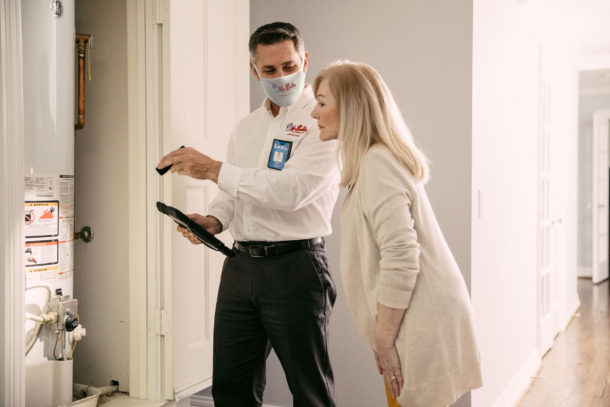
Customers expect professionalism
If a homeowner is paying a professional to complete a home service project for them, they want to feel confident that their money is going toward someone who knows what they’re doing. In the past, a plumber’s success was based on how well they could “paint a verbal picture” of the issue and its solution for a customer. Nowadays, a plumber who arrives with a mobile device or tablet ready to visually explain their recommended approach instantly increases his/her credibility as a trusted advisor as opposed to a salesman. Figuring out how to appropriately use technology to convey expertise is a skill that requires more advanced and ongoing training of your technicians, but it’s worthwhile to ensure your team can respond to service requests with the utmost professionalism.
Electronic communication also streamlines transactions between providers and customers. Invoices can be delivered directly via email so they don’t get lost in the mail. Messages can be sent and received in real time so there’s no frustration over playing phone tag. Customers can better prepare a technician for their visit by sending photos and videos of the issue at hand, which makes for a more prepared technician upon arrival. All of this conveys the image you want of an experienced and professional provider.
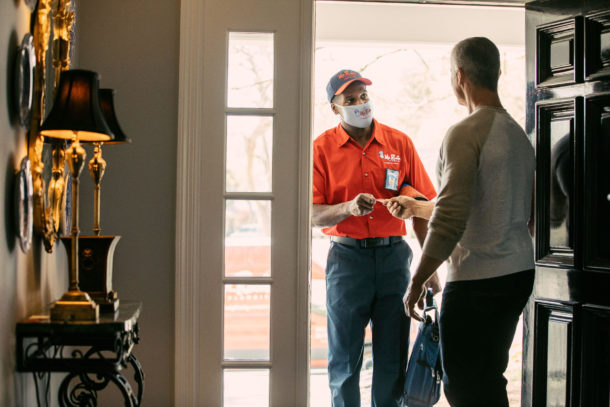
Customers want to feel safe
Being an essential service provider during a pandemic is both an opportunity and a challenge. While issues that require a plumber cannot be ignored, it is also a health risk both to the homeowner and to the technician alike for us to deliver those services directly to an individual’s home. Being invited into people’s homes in order to do our jobs is a privilege, especially in today’s environment, making it absolutely necessary to work safety measures such as wearing masks, washing hands, maintaining social distance, and more into our standard service call procedures.
With technology, we can take our precautionary measures a step further to create an experience as close to contactless as possible. Electronic capabilities for transactions such as providing estimates, sending invoices, and receiving payments are a must. For the service call itself, being digitally connected with our customers allows us to send arrival alerts, to pre-screen customers, and to possibly even provide expertise and direction entirely virtually for select home maintenance jobs that homeowners could accomplish themselves. By introducing these creative approaches to doing what is usually a very hands-on job, we show our customers that we realize giving them the best and most comfortable experience goes far beyond the job itself.
The time to evolve is now
Of course, the idea of implementing all of this advanced technology to your plumbing business may be a daunting concept for some contractors. You might even question if it’s worthwhile if the old-school business model you’ve always had is still working as far as you can tell. But with the growing prevalence of technology across all industries, chances are refusing to adapt will leave you behind your competitors who are rising to the occasion.
If you’re not comfortable making the changes yourself, consider hiring a consultant or perhaps even converting your business to a franchise model like Mr. Rooter to get the digital support you need. But one way or another, it’s time for your plumbing business to step into the future.
 Glenn Gallas is the Vice President of Operations for Mr. Rooter Plumbing, a Neighborly company. Glenn’s career in franchising began as a franchise owner in 2000 of a Mr. Rooter Plumbing franchise. Glenn became a multi-franchise owner when he purchased a Mr. Electric franchise and then a Holiday Lighting franchise. Glenn is a veteran and has served in the US Army in both the active and reserve capacity and sees franchising as the best fit opportunity for veterans transitioning from the military to civilian life.
Glenn Gallas is the Vice President of Operations for Mr. Rooter Plumbing, a Neighborly company. Glenn’s career in franchising began as a franchise owner in 2000 of a Mr. Rooter Plumbing franchise. Glenn became a multi-franchise owner when he purchased a Mr. Electric franchise and then a Holiday Lighting franchise. Glenn is a veteran and has served in the US Army in both the active and reserve capacity and sees franchising as the best fit opportunity for veterans transitioning from the military to civilian life.
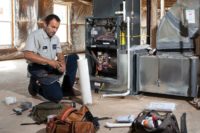
Increase customer satisfaction with efficient, right-sized propane HVAC systems Navigating the world of HVAC systems can be daunting for homeowners. It’s a big reason why homeowners tasked with selecting the right HVAC system — either in a new build or as a replacement to an existing system — will often turn to the pros for Read more
Increase customer satisfaction with efficient, right-sized propane HVAC systems
Navigating the world of HVAC systems can be daunting for homeowners. It’s a big reason why homeowners tasked with selecting the right HVAC system — either in a new build or as a replacement to an existing system — will often turn to the pros for guidance.
Customers often prioritize quality and price, but there’s another component that’s equally important: size. Selecting and installing a right-sized HVAC system is key to keeping customers comfortable and satisfied year-round.
Installing incorrectly-sized systems can underperform, waste energy, and increase utility costs for homeowners. More specifically, a system that’s too small might not be able to regulate the temperature of the home. An oversized unit, on the other hand, will not work as efficiently, may wear out faster, and could have dehumidification problems.
Most importantly for professionals, is that a well-performing HVAC system can ensure a lifetime customer, so knowing what to recommend when homeowners come calling can have lasting benefits for the business.
It’s all in the details
Determining heating and cooling loads plays an essential role in sizing HVAC systems like A/Cs, heat pumps, and furnaces. Many existing homes have over-sized heating oil or propane furnaces, resulting in heating systems that blast warm air, almost too quickly, when the thermostat calls for heat. Furnaces that are properly sized for the home’s heating load, on the other hand, offer greater comfort — often with a smaller, less expensive unit. HVAC contractors can use a load calculator, which considers the home’s climate region, square footage, insulation grade, sun exposure, and more.
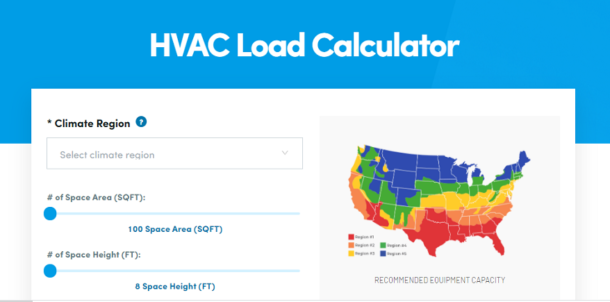
Every home is different, which is why it’s important that heating and cooling systems are designed for the correct load. Did you know that the same house, rotated just 90 degrees, could vary in cooling load by 25 percent or more? These calculations take time and require attention to detail, but will greatly impact a home’s performance, a customer’s satisfaction, and potentially your business’ reputation.
Understand and evaluate load size
A home’s heating and cooling loads drive how much an HVAC system needs to operate to keep a home — and your customers — comfortable year-round. It’s important for HVAC contractors to understand the three different types of loads, the amount of heating or cooling a home needs, and how they relate to a unit’s capacity to provide the best HVAC experience for their customers.
Heating load and capacity can often be easily confused. Heating load refers to the amount of heating or cooling a building needs, while heating capacity is the amount of heating or cooling an HVAC appliance can provide. HVAC professionals base the size of the systems they install on their capacity to satisfy three different kinds of loads — design load, extreme load, and part load.
Design load
The design load includes the layout of a home, its overall energy efficiency, its insulation levels, and its orientation to the sun. Homes with adequate insulation, thermal windows, and little air infiltration have lower design loads. Conditioning loads will differ between single- and two-story homes. If HVAC professionals size a home’s heating and cooling equipment to meet design loads exactly, they may unintentionally specify and install wrong-size equipment.
Extreme load
The extreme load occurs when experiencing the hottest and coldest temperatures in any given location. This load, unlike the design load, carries little weight when HVAC professionals calculate the appropriate HVAC equipment size. Plus, extreme weather conditions rarely last long enough to significantly impact a home’s overall performance and comfort.
Part load
Partial loads are the most common. During much of the day and throughout the year, heating and cooling loads fall between the design load and the extreme load. Properly-sized equipment may cycle on and off, which can impair comfort, energy efficiency, and humidity control. Fortunately, modern HVAC systems often come with variable-speed and level components that allow the equipment to adapt its running speed or level to current conditions.
Consider the energy source
Once an HVAC professional has determined the correct load and unit capacity, they can select which energy source will power the system. Propane has become an increasingly popular choice among homeowners across the U.S. because it delivers energy savings, reduced emissions, and comfort — all at an affordable cost. In fact, in some regions, high-efficiency furnaces are the most commonly installed system for new homes. In regions where an air-source heat pump is specified, pair it with a propane auxiliary unit instead of electric coils and the unit still provides comfort when outside temperatures fall below 45 degrees Fahrenheit.
High-efficiency propane furnaces offer best-in-class efficiency with ratings from 90 to 98 percent and the versatility to provide space heating to both small floor plans and large custom homes — making them a valuable addition to any project.
To learn more about propane HVAC systems, visit Propane.com/Furnaces-Boilers.
 Bryan Cordill is the director of residential and commercial business development at the Propane Education & Research Council. He can be reached at bryan.cordill@propane.com.
Bryan Cordill is the director of residential and commercial business development at the Propane Education & Research Council. He can be reached at bryan.cordill@propane.com.

Now more than ever, homeowners are looking for alternative ways to safely address seasonal maintenance needs and/or home repairs given changes to standard procedures set in place due to the COVID-19 pandemic. From social distancing protocols to mask requirements, home visits provide new challenges. The HVAC industry has worked quickly to adapt to this new Read more
Now more than ever, homeowners are looking for alternative ways to safely address seasonal maintenance needs and/or home repairs given changes to standard procedures set in place due to the COVID-19 pandemic. From social distancing protocols to mask requirements, home visits provide new challenges. The HVAC industry has worked quickly to adapt to this new normal. Our professionals continue delivering necessary services to homeowners in a safety-first way, especially as we enter peak cooling season, to ensure HVAC systems operate smoothly and are prepared to withstand the summer heat.
With new precautions in place that impact in-person maintenance appointments, the need for digital dealers with remote solutions has become more urgent. Digital remote technology provides technicians with resources to streamline the service process, which enables an HVAC technician to investigate a system from afar with the safest and most cost-effective strategies. Further, the rise of the digital dealer and remote capabilities reinforces how smart technology can bring homeowners convenience, comfort and peace of mind.

As a trusted HVAC partner, we can share tips for approaching cooling season more efficiently through remote diagnostics.
Stay in tune with the latest remote diagnostic capabilities
- Take advantage of training programs to better understand how the remote diagnostic programs operate. Learn how/when to use these offerings to determine if an in-person visit is necessary, or if the issue can be resolved without having face-to-face contact with the homeowner. These programs offer a more holistic explanation of remote diagnostics, allowing you to add more tools to your virtual toolbox. Also, it’s important to stay in touch with your network to learn about future training opportunities, as well.
Clearly communicate the benefits of digital offerings to the homeowner
- Many homeowners assume that HVAC updates or fixes can only be handled by having a technician physically enter their home. In the era of COVID-19, there is heightened concern as to how safe it is to have someone entering the house, particularly when an immune-compromised person is living in the household. With remote diagnostics and the homeowner’s permission, it’s possible to access the system’s information, diagnose the issue, and sometimes completely address the issue remotely. If the matter cannot be fixed remotely, some diagnostics programs allow the technician to determine what parts will be needed for the in-person repair, let the tech explain the situation by phone and thereby greatly reduce the time spent inside the customer’s home.
- Because remote diagnostics is new to most customers, it’s important to share easy-to-follow infographics, short commercial assets, and other digestible materials that clearly explain the benefits of this new offering. Have these materials readily available on your tablet or online for homeowners to review and build confidence in opting into this service.
Be overly responsive and aware of your customer’s concerns
- Knowing in-person service calls have been halted or delayed due to COVID-19, thorough communication and frequent touch bases with your customers are even more important. Looking ahead to heating season, continue to reinforce the benefits of remote diagnostics and remain ready to inform customers of alternative solutions and safety protocols.
Following these tips and procedures paves the way for sustained growth for digital dealers and provides homeowners another way to make sure their systems are running properly – whether or not in-person visits are an option.
 Carri Norton, Portfolio leader for Nexia Diagnostics on behalf of American Standard Heating and Air Conditioning.
Carri Norton, Portfolio leader for Nexia Diagnostics on behalf of American Standard Heating and Air Conditioning.

As a homeowner, I know firsthand the fear of experiencing water damage in the place I find the most comfort. But as someone who works in the plumbing technology industry, I know there is a way to receive alerts the moment a pipe bursts or an appliance fails so I can call my plumber before Read more
As a homeowner, I know firsthand the fear of experiencing water damage in the place I find the most comfort. But as someone who works in the plumbing technology industry, I know there is a way to receive alerts the moment a pipe bursts or an appliance fails so I can call my plumber before irreversible damage occurs.
Certainly, you’ve done your fair share of leak repairs as a contractor. They’re so common that Chubb reported 45% of homeowners have experienced a water leak or know someone who has, and, according to the Insurance Information Institute, water damage insurance claims are 3 times more likely than theft and fire claims combined. And with nearly every burst pipe or fixture leak, there’s a frantic call to a local plumber for an emergency repair.
Fortunately, Chubb also found that 93% of all water damage can be prevented, and there’s technology that helps protect your customers against these costly and devastating leaks. Recommending and installing this technology for your customers can help position you as a hero.

Smart Leak Detection Devices: What Are They?
Most leak detectors today are Wi-Fi connected smart home units that track water activity in the home and alert users to potential leaks.
Some devices take leak detection a step further to offer complete protection by:
- Tracking water throughout the home through the main water line.
- Monitoring conditions that lead to plumbing system issues such as freezing temperatures, high and low pressure, and excessive humidity.
- Offering a mode that automatically shuts the water off if a leak is detected while the homeowner is away.
- Alerting users of abnormal water usage while they’re at home.
- Detecting slow drips behind the wall, via a pressure decay test, which can cause mold and property damage if left untreated.
- Integrating with smart home technology such as Google Assistant or Amazon Alexa to make leak detection more convenient.
- Providing the ability to control multiple devices across multiple properties, such as a second home or vacation property, in one app.
Smart home leak detection devices are a must-have for homeowners who want to protect their investment and avoid high water remediation and property replacement costs. And you can be the one to present the solution to them.
Offering Leak Detection Installation Services
Why offer leak detection installation services to your customers? You will add value to your customer and your business with a product every home should have — just like smoke and security alarms. This gives your customers peace of mind, as they know you’re using advanced solutions to keep them protected. You will also build a trusting relationship for callbacks if the device does detect a leak or pressure issue that requires a professional.
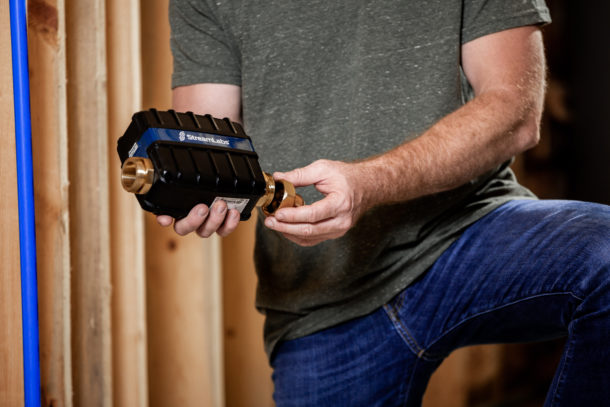
Additionally, if customers with installed leak detectors do experience a leak, they can turn off their water before you arrive so you don’t have to find the main water line, turn the water off and trudge through water to get to the leaking pipe. The result is quicker repairs for you and less frustration for them.
Plus, you will save your customers money on water remediation and property restoration services by installing a device that helps protect them against catastrophic leaks and costly water bills.
Building Awareness About Your New Services
Once you decide to offer leak detection device installation as a service, you’ll want to tell your existing and potential customers. Consider these tactics for letting customers know about your new services:
- Promote it online and in-person. Share more about your new offerings through social media, email and in-home sales pitches. Around the holidays, you may even consider promoting a customer referral program where people can get and give a discount on their leak detection device installation.
- Educate customers on leak detection. In your communications about the new leak detection service, include the frequency and cost of leaks and appliance failures. You may also mention the likelihood of another leak happening after the first one, which is 2 to 3.5 times more likely, according to data from American International Group. If the customer’s home contains an older plumbing system or they’re in a part of the country that’s susceptible to freezing temperatures, you may use this to give them a sense of urgency about installing a leak detection system.
- Show, don’t just tell. While most homeowners are aware that leaks can happen any time, they may not realize they can do something to help prevent them. Show videos of how leak detection devices work, and keep a device in your truck in case they want to see what the device looks like in person.
- Emphasize the peace of mind. Unfortunately, homeowners can’t always see the effects of a leak until it has caused permanent damage. Explain that a leak detection device can calm their fears about water damage while they’re home or away at work or on vacation.
- Don’t forget multiple property owners. Have clients that own or manage multiple properties? Emphasize the importance of protecting second homes, vacation rentals, investment properties and aging parents’ homes with smart leak detectors that they can control from one app.
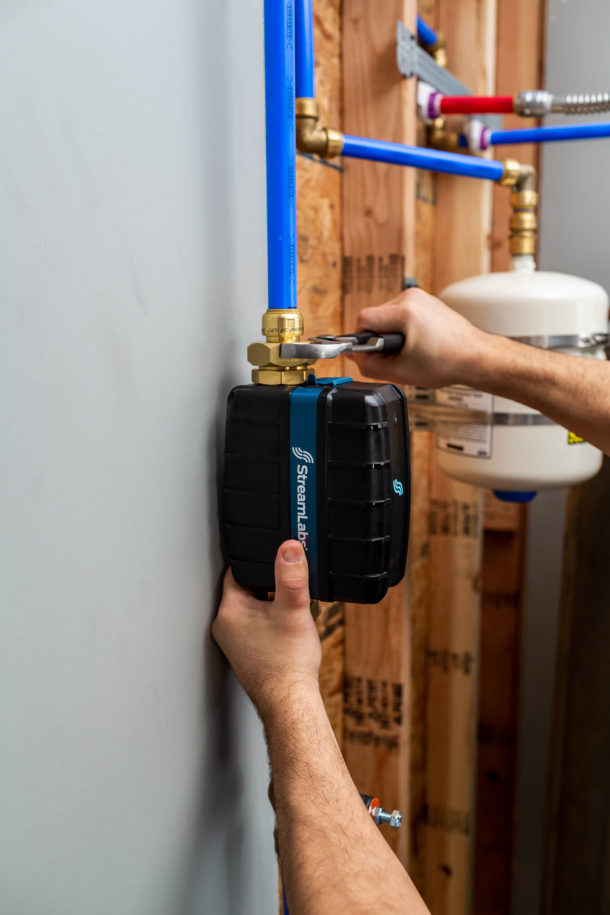
Finding the Right Leak Detection Solution
Your customers need protection against water leaks, and you can be the one to educate them and provide the solution. Learn more about the benefits of offering leak detection services by exploring an installer program, such as StreamLabs, today.
 Cindy Welsh is a sales director at RWC – a market leader and manufacturer of water control systems and plumbing solutions for residential and commercial applications.
Cindy Welsh is a sales director at RWC – a market leader and manufacturer of water control systems and plumbing solutions for residential and commercial applications.
